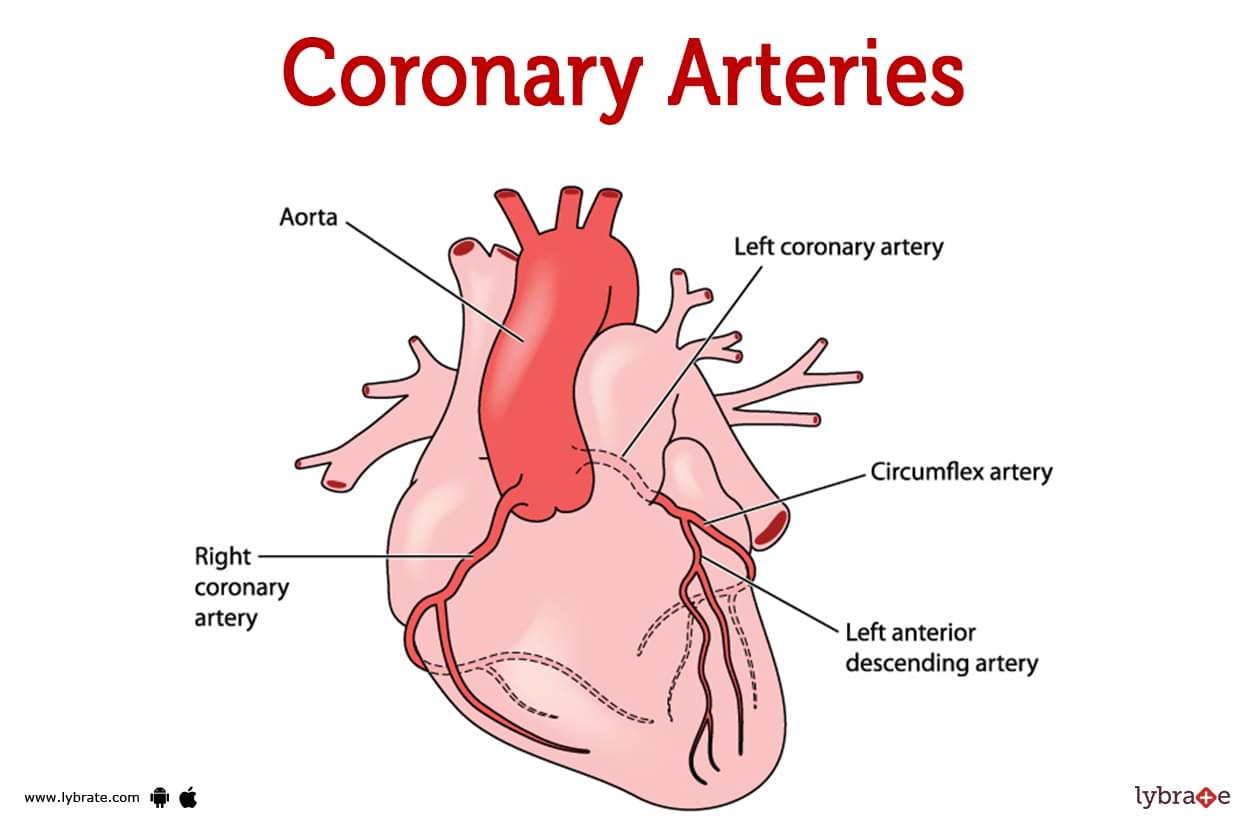Coronary Arteries (Human Anatomy): Image, Functions, Diseases and Treatments
Last Updated: Nov 25, 2022
Coronary Arteries Image
Large blood vessels called coronary arteries are responsible for delivering blood to the heart. They let your heart to beat and circulate blood throughout your body. You have two coronary arteries, one on each side of your heart (LMCA).Each has smaller branches that extend deep into your heart muscle.
To get blood to the heart, both the right and left coronary arteries are necessary. They're offshoots of the major artery in your body, the aorta. The blood from these arteries and their branches reaches every portion of the heart muscle.
Where are the coronary arteries located?
Your coronary arteries surround and run through your heart muscle. They branch from your aorta, which is your body's major artery. They begin at the aortic root, which is the first section of your aorta to emerge from your heart's left ventricle. The left ventricle is where oxygenated blood exits the heart and begins its trip through the body. The coronary artery branches are the first of several branches that emerge from the aorta.
Coronary ArteryStructure
There are two coronary arteries, and each of these arteries has multiple branches, which are as follows:
- Right coronary artery (RCA): Blood is supplied by the RCA to the right atrium as well as the right ventricle. It supplies the SA and AV nodes. These nodes send electrical signals to the heart to contract the muscles. RCA branches deliver blood to one-third of your heart's interventricular septum.
- Left main coronary artery (LMCA): LMCA feeds your left atrium and left ventricle. Here, oxygenated blood from your lungs enters before being pumped by your heart. Its branches feed blood to the interventricular septum's other two-thirds.
Is the structure of the coronary artery always the same?
Coronary artery branch structures vary from person to person.
Example: Coronary arteries are normally surrounded by fat, however in some people they're in the heart muscle. In 10% of persons, the LCMA supplies the SA and AV nodes, not the RCA.
Sometimes a single coronary artery sprouts from the aorta. Most variants are harmless and symptomless. In rare circumstances (less than 1%) coronary artery anomalies might cause mortality.
How big are the coronary arteries?
The main coronary arteries are typically 3 to 4 millimetres in diameter. That is just a hair less than half as wide as a drinking straw. The size of your arteries varies slightly depending on your gender, body weight, and even ethnicity.
What are the coronary arteries made of?
There are three layers in the arterial wall: the intima, the media, and the adventitia.Endothelial cells line the inside of an artery's lumen in a single layer called the tunica intima.
Cells from smooth muscles and collagenous make up the media, which is the intermediate layer. The adventitia comprises of connective tissue and is the outermost layer. The primary purpose of artery walls is to maintain normal blood pressure and ensure unidirectional blood flow.
Cells in the tunica intima generate a number of chemicals that maintain the artery clean and prevent the formation of blood clots. To control blood flow, cells of smooth muscles in the media relax and contract.
Coronary Arteries Functions
The coronary arteries and their branches are responsible for supplying blood to your heart. The oxygen and nutrients in blood are required by your heart muscles in order for them to pump blood through your heart and the rest of your body.
Coronary Arteries Conditions and Disorders
- Stable ischemic heart disease: This is the form that persists. Over time, your coronary arteries gradually shrink. Your heart's blood becomes less oxygenated with time. You may encounter some symptoms, but they are manageable on a daily basis.
- Acute coronary syndrome: This is the enduring form. Your coronary arteries shrink steadily over time. Over time, your heart's blood becomes less oxygenated. You may have some symptoms, but you can handle them on a daily basis.
- Arrhythmias (like atrial fibrillation): Similar to atrial fibrillation, atrial flutter is characterised by more regular heartbeats. Atrial flutter increases the chance of having a stroke. supraventricular tachycardia Supraventricular tachycardia refers to arrhythmias that begin above the lower heart chambers (ventricles)
- Cardiac arrest: A sudden cardiac arrest is defined as the sudden loss of respiration, awareness, and heart function. This condition is typically brought on by an issue with the electrical system of the heart, which disrupts the pumping action of the heart and prevents blood from being delivered to the rest of the body.
- Cardiogenic shock: When the heart suddenly is unable to pump enough blood to fulfil the demands of the body, a condition known as cardiogenic shock can occur. While heart attacks are the most common cause of cardiogenic shock, they are not the only reason.
- Stable angina: This is the one most people go through. Stable angina is angina that comes and goes at a steady rate. It shows up most when you are working hard physically or when you have strong feelings. It goes away when you sleep or take some nitroglycerin.
- Dyspnea: Shortness of breath is a common sign of heart failure, and some people even feel it when they do light exercise.
- Atherosclerosis: Atherosclerosis is a disorder in which the arteries, which transport both blood and oxygen out from heart towards the rest of the body, grow thick and inflexible.This can impede the transport of blood and oxygen to the body's organs and tissues. Arterioles in good health are flexible and can be bent or stretched. However, arterial stiffening can occur over time. Atherosclerosis is the medical term for this condition.
- High blood pressure: The effects of high blood pressure are often felt in the body's arteries. Also known as high blood pressure. The heart has to work harder to pump blood around the body.
- High triglycerides (hypertriglyceridemia): Too many triglycerides, or hypertriglyceridemia, are floating around in the blood. Triglycerides are a type of lipid that have a lot of energy (fat). Some triglycerides come from the food we eat (like butter and oils). Also, when the body has more calories than it needs, it stores them as triglycerides.
- Peripheral artery disease: The legs and arms, and especially the legs, suffer from inadequate blood supply due to peripheral artery disease (PAD). Walking discomfort in the legs (claudication) and other symptoms may result.
Coronary Arteries Tests
- Blood tests( CBC, LFT): Search for potential artery-damaging or CAD-risking chemicals.
- Cardiac catheterization: To diagnose or confirm CAD, a physician may insert tubes into the patient's coronary arteries. When it comes to detecting CAD, this test is the one to beat.
- Computed tomography (CT) coronary angiogram: Taking 3D images of your beating heart with CT and contrast dye. Determines if your heart's arteries are blocked.
- Coronary calcium scan: Determines how much calcium there is in your coronary artery walls (a sign of atherosclerosis). Although this doesn't reveal whether or not you have serious blockages, it does assist pinpoint your likelihood of developing coronary artery disease.
- Echocardiogram (echo): Evaluating the health and condition of your heart through the use of ultrasound.
- Electrocardiogram (EKG/ECG): The device tracks the electrical activity of your heart. Capable of identifying current or past heart attacks, ischemia, and rhythm disorders.
- Exercise stress test: Tests your heart's ability to handle stress. Capable of identifying signs of angina and coronary artery disease.
- Cardiac catheterization and angiogram: Cardiac catheterization involves the careful placement of a thin, flexible tube (catheter) into a blood vessel through an access point such as the wrist or groyne. With extreme care, the catheter is threaded into the heart. X-rays are used as a sort of navigation system. The catheter is a conduit for dye. By enhancing the visibility of blood vessels and outlining any obstructions, the dye facilitates imaging.
- Nuclear stress test: This is quite similar to a standard exercise stress test, with the added benefit of visuals and ECG records. Nuclear stress testing can reveal the normal and abnormal patterns of blood flow to the heart muscle. Radioactive tracers are administered intravenously. Using the tracer, images of the heart's arteries can be seen more clearly.
Coronary Arteries Treatments
- Coronary angioplasty and stent placement: This treatment is used to unblock arteries in the heart. Percutaneous coronary intervention is a synonym (PCI). The cardiologist directs a catheter, a thin, flexible tube, to the blocked area of the heart artery. It involves inflating a tiny balloon to assist open up the narrowed artery and restore blood flow.
- Coronary artery bypass graft surgery (CABG): In order to redirect blood flow in the heart, surgeons sometimes harvest a healthy vessel from another section of the body and transplant it there. The blood then bypasses the coronary artery that is either closed or severely constricted. An open-heart operation is required for CABG. Only people with severe blockages in their cardiac arteries typically undergo this procedure.
- Heart transplant: Transplanting a healthy donor heart into a patient whose own heart is diseased or failing is what is known as a heart transplant.
- Embolization: methods of occluding blood vessels with small particles, typically gelatin sponges or beads. Embolization can be performed to obstruct blood supply to a tumour or other aberrant region of tissue, thereby halting bleeding.
- PDA surgery: The target of PDA surgery is the blood vessel, not the heart. The incision will be made by the surgeon in the child's chest, in the space between the ribs. The doctor will next shut the blood vessel with stitches or clips using small tools inserted between the patient's ribs.
- Lumbar sympathectomy: As an injectable treatment, lumbar sympathectomy cuts off sympathetic nerve impulses and improves blood flow to the skin of the lower extremities. In addition to alleviating discomfort, this may also speed recovery. When injected, phenol can reduce pain for up to 9 months.
Coronary Arteries Medicines
- Steroids for reducing inflammation of Coronary Arteries: Anti-inflammatory medications, such as methylprednisolone, hydrocortisone, and dexamethasone, reduce inflammation, particularly in the coronary arteries. Also beneficial in the healing of arteries following injury.
- Analgesics for pain in Coronary Arteries: Aspirin, ibuprofen, and acetaminophen are examples of medications that can provide some relief from the discomfort caused by inflammation of the cornoary arteries.
- Anticoagulants: These are medications that are given by a medical professional to stop bleeding in the event of an infarct or arrhythmia. Heparin and warfarin are two examples of these medications.
- Antibiotics for infection in Coronary Arteries: Antibiotics with broad spectrum activity, such as ofloxacin, norfloxacin, metronidazole, ceftriaxone, and cefoperazone, are frequently used. Despite the fact that other antibiotics such as clindamycin, gentamicin, and doxycycline are commonly used to treat coronary artery infections.
- Ranolazine: Is an anti-inflammatory medication that helps with erythema of the coronary arteries, radiating chest discomfort, and tachycardia in general.
How can I keep my coronary arteries healthy?
Eat a balanced diet reduced in salt, cholesterol, and saturated fats to protect your heart and coronary arteries.
Engaging in a regular exercise routine. Controlling hypertension. Neither smoking nor using any other form of tobacco. Taking steps to cut back on alcohol use.
Table of content
Find Cardiologist near me
Ask a free question
Get FREE multiple opinions from Doctors



